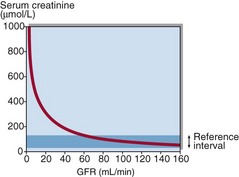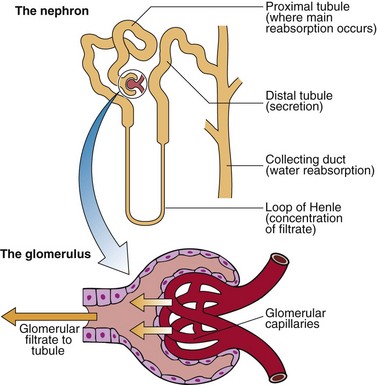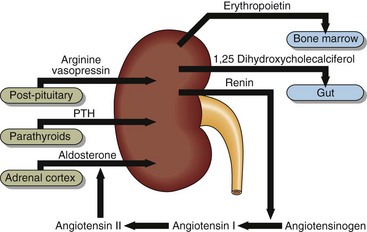14 The functional unit of the kidney is the nephron, shown in Figure 14.1. The functions of the kidneys include: The kidneys are also endocrine organs, producing a number of hormones, and are subject to control by others (Fig 14.2). Arginine vasopressin (AVP) acts to influence water balance, and aldosterone affects sodium reabsorption in the nephron. Parathyroid hormone promotes tubular reabsorption of calcium, phosphate excretion and the synthesis of 1,25-dihydrocholecalciferol (the active form of vitamin D). Renin is made by the juxtaglomerular cells and catalyses the formation of angiotensin I and ultimately aldosterone synthesis. It is convenient to discuss renal function in terms of glomerular and tubular function. The first step in urine formation is the filtration of plasma at the glomeruli (Fig 14.1). The glomerular filtration rate (GFR) is defined as the volume of plasma from which a given substance is completely cleared by glomerular filtration per unit time. This is approximately 140 mL/min in a healthy adult, but varies enormously with body size, and so is usually normalized to take account of this. Conventionally, it is corrected to a body surface area (BSA) of 1.73 m2 (so the units are mL/min/1.73 m2). Historically, measurement of creatinine in serum has been used as a convenient but insensitive measure of glomerular function. Figure 14.3 shows that GFR has to halve before a significant rise in serum creatinine becomes apparent – a ‘normal’ serum creatinine does not necessarily mean all is well. By way of example, consider an asymptomatic person who shows a serum creatinine of 130 µmol/L: Fig 14.3 The relationship between glomerular filtration rate and serum creatinine concentration. Glomerular filtration rate may fall considerably before serum creatinine is significantly increased.
Investigation of renal function (1)
Functions of the kidney
 regulation of water, electrolyte and acid–base balance
regulation of water, electrolyte and acid–base balance
 excretion of the products of protein and nucleic acid metabolism: e.g. urea, creatinine and uric acid.
excretion of the products of protein and nucleic acid metabolism: e.g. urea, creatinine and uric acid.
Glomerular function

Investigation of renal function (1)







